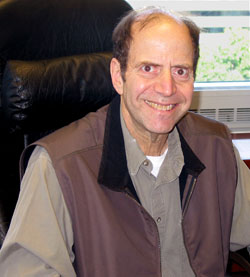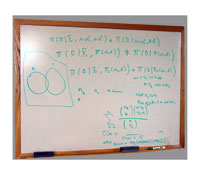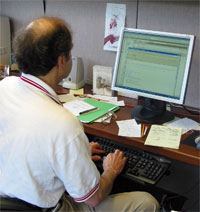 |
 |

|
|
Richard Simon, D. Sc., Biostatistician, Chief, Biometric Research Branch, Head Molecular Statistics and Bioinformatics, National Cancer Institute, National Institutes of Health, Bethesda, Maryland
|
1. I chose this career because...
2. My typical workday involves...
3. What I like best/least about my work...
4. My career goals are...
5. When I'm not working, I like to...
|
|
1. I chose this career because...
|
Back to Top

|

|
|
This dry erase board is covered with complex mathematical computations typically used in biostatistical studies.
|
I chose to become a biostatistician because of an inspiring teacher and the opportunities presented to me during my post-graduate years. In high school, I wasn’t really interested in learning until I began the study of geometry. My older sister was an excellent student, to whom I was always compared. I was questioned, “Why don’t you do better in school like your sister? Why don’t you apply yourself more?” The turning point came when I was in the 10th grade. I had a wonderful geometry teacher who loved her subject. I came to school early to view a TV program and solve math problems with my geometry teacher. This was the time period of the Sputnik flight into outer space and the rediscovery of the importance of mathematics. It was a time when math became very important to me. I realized that I wanted to learn more.
When I finished my undergraduate degree, I didn’t know what I wanted to do. I had won an National Science Foundation fellowship and decided to stay at Washington University to complete my Ph.D. in mathematics.
Post-graduate Training On-the-Job
After completing my graduate degree, I came to work at the NIH. Until that time, I was interested in mathematics, specifically mathematical modeling. At the NIH, everyone came to me with statistical questions. There didn’t seem to be any distinction between statistics and mathematics. I had previous coursework in theoretical statistics, but never found it very exciting or interesting. However, the statistical problems the NIH scientists brought to me were very intriguing. I had to re-train myself while I was trying to solve these problems. My training in biostatistics was on-the-job training. I had to read, research and learn about statistics as I offered my fellow scientists solutions to their problems. My background in applied science made this task doable. My undergraduate engineering courses helped me appreciate the very practical aspects of mathematics.
College Education
|
|
2. My typical workday involves...
|
Back to Top

|

|
|
Richard Simon works at this computer, doing tasks such as writing, analyzing data and developing new analysis software.
|
My typical workday during my early career at NIH involved analyzing other scientist’s data and included the following tasks:
- Understanding the problems brought to me
- Working out a statistical analysis of the data after researching the best method to use
- Writing results so that the scientist understood my statistical analysis, so that it could be included in a publication
- Reading drafts of the scientists’ papers to make sure that my results were included in an accurate and appropriate manner
During this time, I established a network of colleagues that would continue to be a resource to me. I worked hard to do a good job, and developed a reputation for productivity. It paid off in many ways as my career progressed.
Expanding Opportunities and Responsibilities
After several years, I was given the opportunity to start a section and a branch. I became the Chief of the Biometric Research Branch for NCI. I have many people working for me. My daily tasks changed with the position and included more time:
- Writing papers about new methods of analyzing data (an effort built on all the practical experience that I had gained in my early years at the NIH)
- Keeping in-touch with the current clinical trials
- Training post doctoral fellows
- Working with my peers learning new aspects of statistical analysis from them
- Learning about the new field of genomic data. I took courses to learn as much as possible, and began to collaborate with other genomic scientists in the institute.
See the Biometric Research Branch web site for more information about our interests and research http://linus.nci.nih.gov/~brb/.
Over the years, I have published a book on the analysis of genomic data (Design and Analysis of DNA Microarray Investigations), trained post docs, and developed analysis software. At first, the genomic scientists felt that the problem was data management, but eventually saw that the real goal was data analysis.
I believe that the skills Biostatistician’s use are the ability to:
- Use a computer for analyzing data and to write computer programs
- Use statistical analysis to understand data
- State clear objectives when beginning a study
- Actively participate in a study with a full understanding of all the science involved
|
|
|
 |